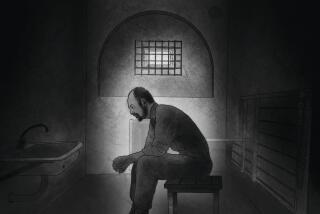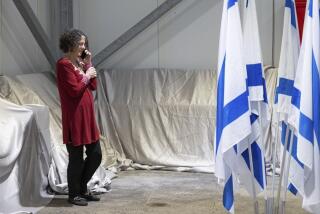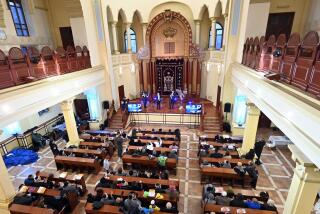New Facts Point Up Horror of Nazi Siege of Leningrad : Warfare: The 900-day blockade was lifted 50 years ago today. Archival materials confirm cannibalism.
- Share via
ST. PETERSBURG, Russia — First they burned the kitchen shelves, then the kitchen table. They burned the wardrobe, and it kept them warm for 22 days. Finally Alexandra Dyen and her son, Vladimir, had nothing left but the family library.
“I burned the German classics, and after that it was Shakespeare,” Vladimir remembered. “I also burned Pushkin. I don’t remember whose edition it was, I think the Marks edition in blue and gold. And into the fire went that well-known multivolume edition of Tolstoy’s works--the books with the gray-green covers and metal medallions in the corner.”
That was in 1941 during the Nazi siege of Leningrad (as St. Petersburg was then called), one of history’s greatest and most gruesome tragedies. Nazi armies encircled Leningrad for nearly three years. Though the Germans bombed it almost every day, their chief weapon was hunger. German scientists carefully calculated rates of starvation and predicted that Leningrad would eat itself within weeks.
Leningraders did resort to cannibalism, but ultimately they proved the Germans wrong--at horrible cost.
Three million people endured the 900-day blockade, which was lifted 50 years ago today. A million or more died, mostly civilians felled by hunger and cold. That’s 10 times the number of deaths caused by the bombing of Hiroshima, and about equal to all American casualties in all U.S. wars combined.
For decades, details of the blockade have been little known in the West. Stalin suppressed the facts of the siege and twisted its history. Until glasnost , the most serious challenge to his version was put forth by New York Times correspondent Harrison Salisbury, who spent 25 years researching and writing “The 900 Days,” a book historians consider the best account in any language.
In honor of the 50th anniversary of the liberation of Leningrad--which the city plans to celebrate lustily, with fireworks and a rare visit by President Boris N. Yeltsin--a Russian-language version of Salisbury’s book appeared on St. Petersburg’s streets two weeks ago, six months after Salisbury’s death.
New findings from the Communist Party archives that were opened in 1992 confirm Salisbury’s contention, widely criticized by leaders of the Soviet era, that murderous gangs roamed wartime Leningrad’s streets, killing for ration cards or human meat.
Paintings, drawings and diaries, some released only this month, show that cannibalism was so much a fact of everyday life that parents feared their children would be eaten if allowed out after dark. New documents show that the city police created an entire division to fight cannibals, and some 260 Leningraders were convicted of and jailed for the crime.
Other new finds include the records of thousands of blockade-era autopsies.
“Not only are they of great interest to history, they are interesting to science in general,” said Dr. Robert Sprinkle of Duke University, part of an interdisciplinary Russian-American team studying the finds, which contain an unprecedented wealth of scientific information on hunger and hunger-related diseases. “There have been many famines, but they haven’t occurred in cities where order has been maintained and careful records kept,” Dr. Sprinkle said.
The basic facts of the blockade have been public record for decades.
The official daily ration was 125 grams of bread, about the weight of a bar of soap. Leningraders supplemented it with anything they could: as historians Ales Adamovich and Daniil Granin wrote in their account of the siege--”with everything from the birdseed to the canary itself.”
They scraped wallpaper down and ate the paste, which was supposedly made from potatoes. They extracted the same paste from bookbindings, or drank it straight from the glue jar. They boiled leather belts and briefcases to make an edible jelly, and plucked and pickled grasses and weeds.
They ate cats and dogs, petroleum jelly and lipstick, spices and medicines, fur coats and leather caps. Some made face-powder pancakes; others munched grimy crystallized sugar, dug out from under the sugar warehouses leveled by German firebombs.
Historians have recorded 22 different dishes made out of pigskin and have collected menus from military factory cafeterias where choices ranged from fern-leaf soup to puree of nettles and milk-curd pancakes.
Scientists at the Vitamin Institute developed diet supplements by extracting Vitamin C from pine needles. They swept attics and ventilation shafts at tobacco factories for tobacco dust, which contains Vitamin B.
At the laboratory where Zinaida Ignatovich worked, bacteria were cultivated for study in a medium with a meat-broth base.
“We had a large stock (of this medium). It saved many of our staff,” Ignatovich said, in an account related by Granin and Adamovich. “I used to extract a glassful when I arrived at work, then all the staff would sit around and I would give them each a tablespoonful.”
Hunger warped and killed Ignatovich’s colleague, a man she respected: “In the mornings, he was always the first at the table. And how feverish his eyes were as they followed that spoon around! You felt all his thoughts were concentrated on it.”
Blokadniki , as survivors are called, number 400,000. Of them, 125,000 were teen-agers or older during the siege. Many again go hungry today.
Proskoviya Romanova was in her mid-teens when the blockade began and well remembers roaming the city streets searching for help for her sick father (he later died), crawling over half-eaten corpses and dodging German bombs. Today a retired language teacher of 69, she lives on a monthly pension of 36,553 rubles (about $22). She buys bread, potatoes, sunflower-seed oil and macaroni. Nothing else.
“I don’t buy tea. Tea is expensive. We have an old store of tea that I built up years ago. I don’t buy apples. I don’t buy oranges,” she said.
Romanova was awarded a medal for the Defense of Leningrad, but her purple knit hat is 10 years old, her pink scarf almost 20. Her last restaurant visit was in 1962.
Sofia Borisova, a 69-year-old retired Red Army corporal, remembers lying in bed during the blockade all but dead.
“My sister would grab me, shake me; she wouldn’t let me die. She arranged for me to be called up into the army, where they fed you much better--still mostly bread, but three times a day,” she said.
“My sister is alive today. We still support each other. We still have to; life is so hard.
“I go to these beautiful new supermarkets. They have everything! I buy a loaf of bread because that’s all I can afford. And I look again at all the wonderful goods on the shelves, and I leave. And I wonder, how can people afford them?”
At the front, in Leningrad’s suburbs, German and Russian soldiers had dug in just 150 feet from each other. The Germans impaled loaves of bread on bayonets and held them up tauntingly. Such taunts instead attracted Leningrad’s rats and crows, which fled to the fatter German lines.
Yet the Russians laughed last. In January, 1943, exhausted soldiers broke through the German ring. One year later, a Russian offensive drove the entire German army out. Leningrad was free.
Later, in the twilight of the Third Reich as Berlin lay under siege, Nazi leaders exhorted their citizens to study the case of Leningrad--and to take heart.
More to Read
Sign up for Essential California
The most important California stories and recommendations in your inbox every morning.
You may occasionally receive promotional content from the Los Angeles Times.










